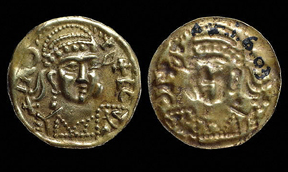
6th century CE
Found in an Astana cemetery, near Turfan, northwest China
Diameter: 1.6 cm
Weight: 0.85 g
Acquisition number: #CM BM Stein [IA.XII.c.1]
Marc Aurel Stein Collection
Image courtesy of the British Museum (copyright reserved)
At first glance, this object discovered in a cemetery near Turfan appears to be a gold coin from Byzantium. Closer examination, however, reveals that it is an imitation, created by hammering a thin sheet of gold over a die carrying the image of a Byzantine solidi. The intentions behind these imitations was not to counterfeit currency, but rather to supply the demand for foreign coins, which were considered exotic items of prestige. These mock coins would be incorporated into jewelry or, like this example, were included in tomb burials.
There exists a millennia-old tradition in China of including models as substitutes for real animals, servants, money, treasures and other material objects in tomb burial hoards. The inclusion of artificial Byzantine coins in tombs may have been an extension of this practice, though not necessarily to the total exclusion of real soldi, which have also been found in northern Chinese tombs of the fourth to seventh centuries CE.